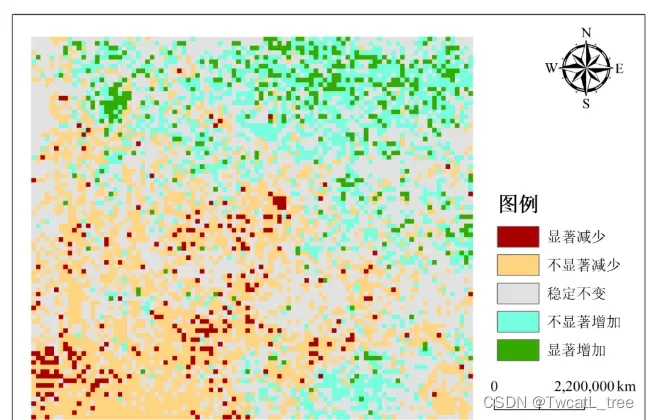方法介绍
1.Theil-Sen Median方法又被称为 Sen 斜率估计,是一种稳健的非参数统计的趋势计算方法。该方法计算效率高,对于测量误差和离群数据不敏感,常被用于长时间序列数据的趋势分析中。对于后续代码计算结果中的slope.tif解读,当slope大于0表示随时间序列呈现上升趋势;slope小于0表示随时间序列呈现下降趋势。
2.Mann-Kendall是一种非参数统计检验方法,最初由Mann在1945年提出,后由Kendall和Sneyers进一步完善,其优点是不需要测量值服从正态分布,也不要求趋势是线性的,并且不受缺失值和异常值的影响,在长时间序列数据的趋势显著检验中得到了十分广泛的应用。对于后续代码计算结果中的z.tif,当|Z|大于1.65、1.96和2.58时,表示趋势分别通过了置信度为90%、95%和99%的显著性检验。
代码介绍
此代码大部分来自Github大佬分享,我修改了报错的个别代码后亲自测试pycharm下只需改路径就可以运行:
# coding:utf-8
'''
已全部实现
'''
import numpy as np
import pymannkendall as mk
import os
import rasterio as ras
def sen_mk_test(image_path, outputPath):
# image_path:影像的存储路径
# outputPath:结果输出路径
global path1
filepaths = []
for file in os.listdir(path1):
filepath1 = os.path.join(path1, file)
filepaths.append(filepath1)
# 获取影像数量
num_images = len(filepaths)
# 读取影像数据
img1 = ras.open(filepaths[0])
# 获取影像的投影,高度和宽度
transform1 = img1.transform
height1 = img1.height
width1 = img1.width
array1 = img1.read()
img1.close()
# 读取所有影像
for path1 in filepaths[1:]:
if path1[-3:] == 'tif':
print(path1)
img2 = ras.open(path1)
array2 = img2.read()
array1 = np.vstack((array1, array2))
img2.close()
nums, width, height = array1.shape
# 写影像
def writeImage(image_save_path, height1, width1, para_array, bandDes, transform1):
with ras.open(
image_save_path,
'w',
driver='GTiff',
height=height1,
width=width1,
count=1,
dtype=para_array.dtype,
crs='+proj=latlong',
transform=transform1,
) as dst:
dst.write_band(1, para_array)
dst.set_band_description(1, bandDes)
del dst
# 输出矩阵,无值区用-9999填充
slope_array = np.full([width, height], -9999.0000)
z_array = np.full([width, height], -9999.0000)
Trend_array = np.full([width, height], -9999.0000)
Tau_array = np.full([width, height], -9999.0000)
s_array = np.full([width, height], -9999.0000)
p_array = np.full([width, height], -9999.0000)
# 只有有值的区域才进行mk检验
c1 = np.isnan(array1)
sum_array1 = np.sum(c1, axis=0)
nan_positions = np.where(sum_array1 == num_images)
positions = np.where(sum_array1 != num_images)
# 输出总像元数量
print("all the pixel counts are {0}".format(len(positions[0])))
# mk test
for i in range(len(positions[0])):
print(i)
x = positions[0][i]
y = positions[1][i]
mk_list1 = array1[:, x, y]
trend, h, p, z, Tau, s, var_s, slope, intercept = mk.original_test(mk_list1)
'''
trend: tells the trend (increasing, decreasing or no trend)
h: True (if trend is present) or False (if trend is absence)
p: p-value of the significance test
z: normalized test statistics
Tau: Kendall Tau
s: Mann-Kendal's score
var_s: Variance S
slope: Theil-Sen estimator/slope
intercept: intercept of Kendall-Theil Robust Line
'''
if trend == "decreasing":
trend_value = -1
elif trend == "increasing":
trend_value = 1
else:
trend_value = 0
slope_array[x, y] = slope # senslope
s_array[x, y] = s
z_array[x, y] = z
Trend_array[x, y] = trend_value
p_array[x, y] = p
Tau_array[x, y] = Tau
all_array = [slope_array, Trend_array, p_array, s_array, Tau_array, z_array]
slope_save_path = os.path.join(result_path, "slope.tif")
Trend_save_path = os.path.join(result_path, "Trend.tif")
p_save_path = os.path.join(result_path, "p.tif")
s_save_path = os.path.join(result_path, "s.tif")
tau_save_path = os.path.join(result_path, "tau.tif")
z_save_path = os.path.join(result_path, "z.tif")
image_save_paths = [slope_save_path, Trend_save_path, p_save_path, s_save_path, tau_save_path, z_save_path]
band_Des = ['slope', 'trend', 'p_value', 'score', 'tau', 'z_value']
for i in range(len(all_array)):
writeImage(image_save_paths[i], height1, width1, all_array[i], band_Des[i], transform1)
# 调用
path1 = r"E:\Test\ACMEI\ACMEI"
result_path = r"E:\Test\ACMEI\ACMEImk"
sen_mk_test(path1, result_path)
后续处理三步走
1.对于生成的tif栅格,只需要取slope.tif以及z.tif进行重分类。
slope>0赋值1表示增加 |z|>1.96赋值2表示显著
slope=0赋值0表示不变 |z|<=1.96赋值1表示不显著
slope<0赋值-1表示减少
(此处还可根据显著性阈值再细分为更多类,我仅作基本演示分为5类)
2.再相乘得到
-2:显著减少;-1:不显著减少;0:稳定不变;1:不显著增加; 2:显著增加
3.在Arcmap出图即可!

版权声明:本文为博主作者:TwcatL_tree原创文章,版权归属原作者,如果侵权,请联系我们删除!
原文链接:https://blog.csdn.net/qq_15719613/article/details/135680331
